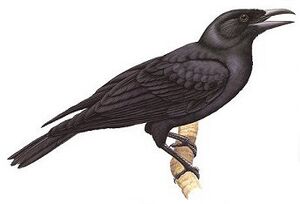Mariana crow facts for kids
Quick facts for kids Mariana crow |
|
|---|---|
 |
|
| Conservation status | |
| Scientific classification | |
| Genus: |
Corvus
|
| Species: |
kubaryi
|
The Mariana crow (Corvus kubaryi), also known as åga in the Chamorro language, is a special type of bird. It belongs to the crow family. This crow lives in the tropical Western Pacific region. It is a shiny black bird, about 15 inches (38 cm) long. You can only find it on the islands of Guam and Rota.
This bird is very rare. Its numbers have been steadily dropping since the 1960s. On Guam, there are no native Mariana Crows left. This happened because of the brown tree snake, which was accidentally brought to the island. On Rota, there are fewer than 200 of these crows left. The main problems there are less suitable habitat due to building, and other animals eating them.
Even though some crows were moved from Rota to the Guam National Wildlife Refuge in the late 1990s and early 2000s, the Mariana crow was gone from Guam by 2011. Today, people are working to protect their habitat on Rota. They also have a program to raise crows and release them into the wild. The International Union for Conservation of Nature says this bird is "critically endangered". This means it is in great danger of disappearing forever.
Contents
What Does the Mariana Crow Look Like?
The Mariana crow is a small black crow. Its tail has a bluish-black shine. Its back, belly, head, and wings have a greenish-black shine. Female crows are usually smaller than males. An adult crow weighs about 9 ounces (260 g). It is about 15 inches (38 cm) long.
Mariana Crow Sounds
Mariana crows make many different sounds. They have two main calls to stay in touch with their partners, family, or flock. One call is a high-pitched series of one to three caw or hi sounds. The other is a series of longer caw sounds with a nasal aaa part. This second call might be used only between mated pairs.
When there is danger, they make a quick series of sharp caw sounds. These are their alarm calls. The birds also make various squawking, guttural sounds. They can make these sounds quietly or very excitedly.
Where Do Mariana Crows Live?
The Mariana crow lives in both new and old forests. It also lives in plants along the coast. However, it only builds its nests in native limestone forests. It prefers to build nests high up in two specific types of trees. These are the yoga tree (Elaeocarpus joga) and the fig Ficus prolixa.
The crow used to live all over the forested areas of Guam and Rota. It disappeared from southern Guam in the 1960s. By the 1970s, it was gone from central Guam. It mostly lived around Andersen Air Force Base. Its population on Rota has also gone down.
What Do Mariana Crows Eat?
The Mariana crow is very flexible about its food. It is an omnivore, meaning it eats both plants and animals. It eats insects, lizards, and other birds' eggs. It also eats hermit crabs, fruits, and seeds.
Reproduction and Life Cycle
Mariana crows start building nests as early as July and as late as May. Their nest is a large, cup-shaped platform. It is made of small sticks and lined with plant fibers. A female crow lays between 1 and 4 eggs. Both parents take turns sitting on the eggs to keep them warm. They also care for the baby birds, called chicks. They continue to care for the young birds even after they learn to fly.
Parents can care for their young for a long time, from 5 to 18 months. Young crows might take up to 3 years before they are old enough to have their own babies.
Protecting the Mariana Crow
On Guam, the main reason Mariana crows disappeared was because of the brown tree snake (Boiga irregularis). This snake was brought to the island by accident. Even with special barriers around nesting sites, the remaining birds were not able to have many babies.
On Rota, many other things threaten the crow. These include new homes being built, resorts and golf courses, and farms. rats and the Mariana monitor lizard (Varanus tsukamotoi) also eat their nests. Strong storms called typhoons can also harm them. feral cats and diseases are also a problem. The black drongo (Dicrurus macrocercus) competes with them for food and space. More recently, the brown tree snake has also been seen on Rota. If this snake population grows, it could cause serious problems for the Mariana crow there. Some people on both islands also see the crow as a problem for new buildings and development.
In 1993, a National Wildlife Refuge was created on Guam. This was done to protect the remaining forest. Some crows were moved from Rota to Guam to help. Scientists are also discussing ways to control the brown tree snake.
Crows were moved from Rota to Guam in 2003 to help with conservation. However, this might have accidentally reduced the variety in the crow's genes. Tests have shown that the Rota population has less genetic diversity than the Guam population did.
The Mariana crow was once listed as an endangered species. But experts thought it might be even rarer than believed. After checking its status, this was found to be true. So, in 2008, it was moved to the "critically endangered" list. This means it is in immediate danger of extinction. There are so few birds left that one big event, like a disease outbreak, could wipe them all out.


